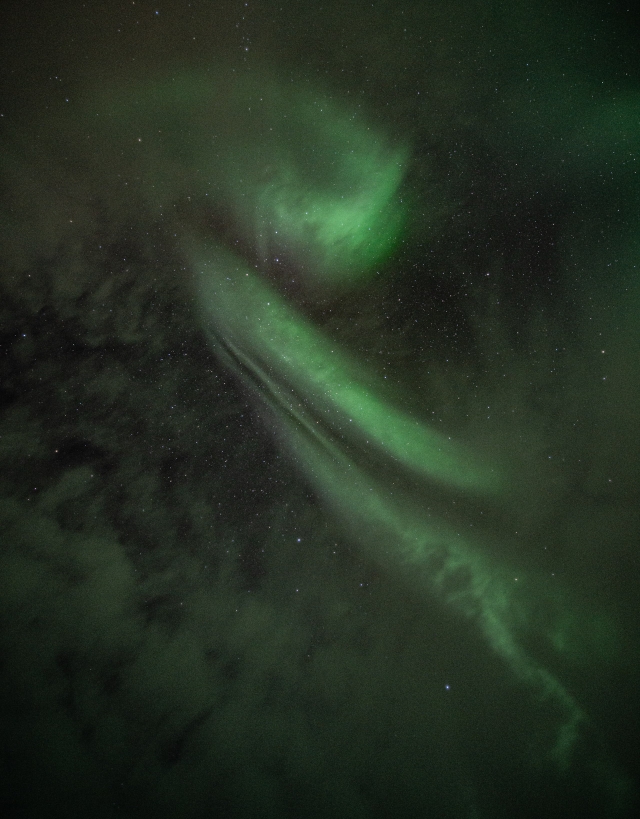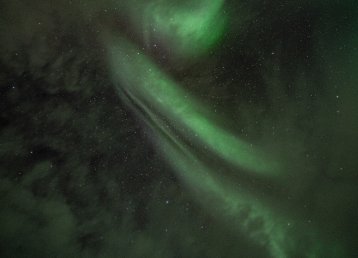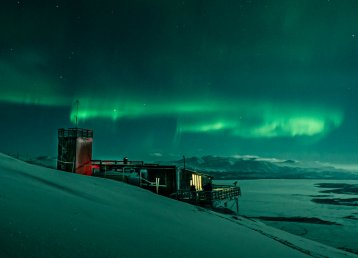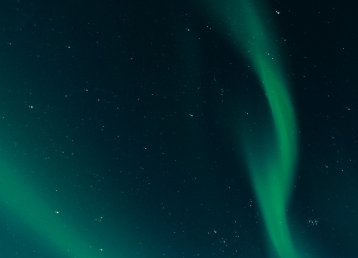Northern light photographer Mia Stålnacke has a squirrel on her balcony, and she’s named it Galileo. It’s no coincidence. Galileo Galilei gave the northern lights their Latin name, aurora borealis, and in many ways, northern lights and space are Mia’s life. Mia and Galileo have developed a friendship since the summer. Sometimes during the day she’ll go outside, call his name and feed him some nuts. At the same time, Mia is hoping to get some good pictures of the little gatherer. But he’s not that much of a friend just yet. By the way, Mia’s dog is Tellus, that’s no coincidence either.
– It’s so incredibly powerful when you’re outside watching the northern lights. But even if that’s what my Instagram and Twitter are most known for, the pictures of the northern lights, I’ve decided to photograph other things too.
– So now I’m taking pictures of the moon, the Milky Way, comets and hopefully shooting stars, as well as details, streaming light and completely normal sunsets. Hopefully some of Galileo too, soon.
Polar nights, northern lights and midnight sun
To Mia Stålnacke in Kiruna, it wasn’t always obvious that she’d become a northern lights photographer – with @angrytheinch being one of the best and most informative accounts on both Twitter and Instagram. It was quite a long trip, and it wasn’t always easy. Her love and fascination for the night sky and space were already there when she was a child.
– It’s almost impossible not to experience space when you live in Kiruna. A place with very little light pollution, with a polar night that’s part of life, and the northern lights and the midnight sun as variables.
– I read about the planets and space, and I was completely engrossed in it.
But in her teens, Mia ended up in another phase of life, where panic and eating disorders led to hospital admission. Instead of looking up to the sky, to embrace and to be embraced by the grandeur of the infinite universe that is our life, she was tormented by it. Instead of looking up, she’d look down at her shoes as she was walking.
– I still remember when I got a new doctor, how I went there and thought: I wonder what kind of nonsense this one will come up with.
– When he said that the most common advice in these circumstances was to try to get people to discover nature, I understood he was just as stupid as the rest of them. That’s what I was afraid of. It almost scared the life out of me.
The difference between captured moments and the lived
Then one night she stepped outside. She was going to disprove the doctor, a bit defiantly. She looked up. There was hoarfrost, and moonlight and the whole world sparkled as if sprinkled with diamonds. She just stood there. Stood there and watched a twig highlighted by the moon. She stood there for an hour or more and just watched and breathed the glistening white winter world. She felt something change inside of her. Shortly afterwards, Mia was given one of her parents’ old cameras. She started taking photos of everything that came her way.
Picture after picture, seeing the difference between the captured moment and the lived. She loved taking photos. She says not many of the photos came out well, but she could see the difference between what was good and what didn’t work. In that sense, she’s almost a self-taught photographer.
– Sure, you can find almost any kind of knowledge through Google and YouTube these days. At least the technical part. But I wasn’t quite there in my life. It was down to details and experiences. The camera became my true excuse just to get out.
– Get out into life.
About 3,000 northern lights
One night there were northern lights outside. An enormous display of northern lights. Mia wanted to capture it. But no matter how she tried, there was no way of capturing it using the camera’s automatic settings. She understood she’d have to do something different.
– I set it to manual. I can’t remember what aperture I set, but I remember pressing the button, and the shutter was set for at least 50 seconds. When I checked the screen, there was a green light there.
– Even if the picture was useless, I felt happiness. I’d succeeded. I’d caught it.
After that incident, Mia Stålnacke has gone on to capture plenty of northern lights. Well, she estimates that she’s seen 3,000 northern lights or more during the last few years.
Watch Mia’s story about her relationship with the breathtaking northern lights.
Photography and space
Mia joined Instagram in 2012, but she started to add the majority of photos during 2014. Since then she’s built a steady number of followers, and she runs one of the most informative northern lights and astrophotography accounts available. The US business magazine Forbes wrote a very good story about her and her photography – most of it based on who Mia’s followers are. The number of followers keeps growing, and they are very interested and knowledgeable. Not just when it comes to photography, but about space itself.
– Of course, I get the odd question from people who still think Earth is flat, or more commonly hollow, but usually, it’s only people who really understand space.
Also read
Astrophotography in Swedish LaplandThe feeling of the end of Earth
The most common question asked of a northern lights photographer is if it looks the same in real life as it does in the photo. So we ask Mia that very question.
– Haha, of course not. More or less nothing looks the same “in real life” as in a photo. There are also two aspects of this when it comes to northern lights photography.
– One is that when the northern lights are weak or normal, the human eye can’t perceive all the different light nuances as a modern camera does. Imagine recording a film for 20 seconds and then compressing everything that happens into one single frame. It’s kind of the same thing that happens when you take photos with low shutter speeds.
– The other thing to keep in mind is that when the northern lights are really good, they can never be captured as an image. I’ve never managed to, in any case.
– You know, I’ve experienced northern lights when I’ve basically ducked down because it feels like the light play is going to hit the ground. You can never capture that in an image — that feeling of absolute magic.
Mia goes on to explain how the experience has become something even more incredible now that she understands what’s going on.
– But of course, you can imagine how people in the north must have felt about the northern lights in the past. The feeling of the end of the earth must have been so tangible.
The sign of everything working just fine
The northern lights are in actual fact just a sign that everything is working just fine. That the magnetic field in the atmosphere protects us from particles, the sun hurls out during its solar storms. Because that’s what’s going on. The sun is the source of the northern lights’ energy. Solar wind plasma is steadily flowing from the sun at speeds of around 400 km/s. Part of the energy received by the magnetosphere accelerates electrons and ions. The Earth’s magnetic field directs these electrons towards the polar regions. At the height of about a hundred kilometres, these charged electrons begin to collide with the components of the atmosphere. The atmosphere heats up, and some ions absorb energy, and it’s this excess energy that’s emitted as light visible to humans.
The different colours of the northern lights simply depend on at what height in the atmosphere some atoms, or kinds of atoms, collide and charge. So the northern lights are just proof that everything is as it should, and without this protection provided by the atmosphere’s magnetic field a lot of our electrified society would be completely impossible and instead be knocked out with every larger solar storm, Mia says.
The hunt for a cloudless sky
We go to Nikkaluokta. One of Mia’s favourite roads when she’s hunting the northern lights. Or rather, and as she explains it:
– It’s not about a hunt for the northern lights, really. Up here in the north, above the arctic circle with polar night during parts of the winter, it’s nearly always northern lights. What you’re really hunting for is a cloudless sky.
Today it’s overcast in Kiruna, but the weather forecast looks good for both Nikkaluokta and Abisko. Mia chooses the Nikka road for several reasons.
– I know that Abisko is probably the safer bet for the northern lights, that the unique weather conditions there often creates a blue hole that you can see the northern lights through. But I like the Nikka road because it’s got less traffic and then there are so many good spots along the way to stop.
– And today the forecast is the same for both.
We stop at the bridge in Nikkaluokta. It’s bitterly cold. -27 degrees Celsius with a wind blowing a couple of metres per second and damp air pulling in, giving a warning about snow. But it’s still clear, with visible moon and stars. The Vistas Valley and the entire Kebnekaise Massif can clearly be seen. Mia takes a couple of photos of the moonlight – she also uses the moon to set the sharpness of the images. A good, simple trick. There are no northern lights. We get into the car. Feeling cold. Suddenly Mia leans forward and looks out the windscreen.
– Now, now they’re starting.
Never the expected
We go outside and let the cameras do their work. The northern lights lie like a bright green line straight across the sky. It’s there for perhaps ten minutes, and then it disappears. We feel a bit empty. The dream of a crackling, vital spectacle across the sky is there. Mia says:
– I think that’s the most important piece of advice I have to give: keep your expectations down. Every time I go to watch the northern lights, that’s what I bring home with me. My experience that it will never be just like I expected it to be.
– Sometimes the forecast is amazing, but the lights turn out mediocre. Sometimes the forecast is a bit so-so, but for a couple of seconds or minutes, the show goes completely crazy. You can’t predict it.
– Or like the northern lights, we just saw. I’ve got perhaps 3,000 nights of northern lights behind me; still, I’ve never seen it like that. Distinctive, just like a ray of light straight across the sky.
– I think it made for a good picture as well.
Follow Mia on Instagram, @angrytheinch.


































